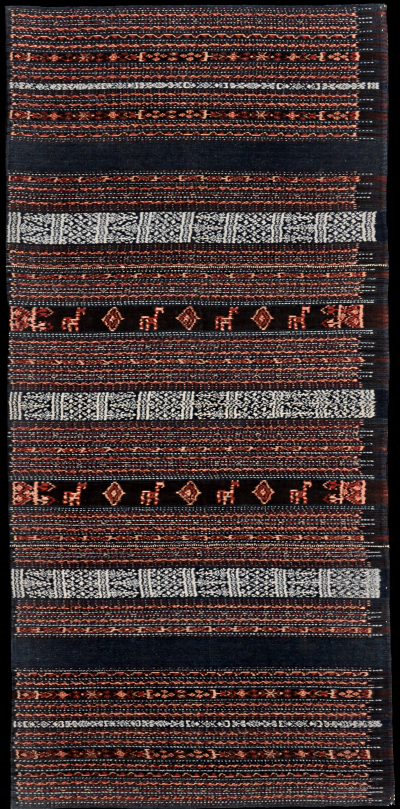| |
 
 | | | |
259 Flores Group, Ende
Zawo (sarong)  
| | Locale: | Probably Ende proper. | | Period: | 1910-1930 | | Yarn: | Cotton, hand-spun, medium | | Technique: | Warp ikat | | Panels: | 3 | | Size: | 138.5 x 143 cm (4' 6" x 4' 8") LW: 1.03 | | Weight: | 580 g (20.5 oz), 293 g/m2 (0.96 oz/ft2) | | Design: | Typical banded structure of a classical Ende zawo mangga. Many other Ende sarongs have a clearly defined midfield (often covered in a field-covering array of geometric or zoomorphic small motifs), but in zawo mangga, the whole cloth is divided into ikat bands, narrower and smaller, some mere pinstripes. Often such zawo are decorated predominantly with geometric patterms in indigo. This piece is unusual in that it has two bands of morinda red horses interposed between three indigo bands. | | Comment: | The design, present in several old collections, is an amalgam of two traditional styles, the predominantly indigo zawo mangga and the predominantly red zawo jara, the horse sarong. It has yet to be established if the correct name for this sarong is lawo jara, on account of its horse motifs, zawo mangga on account of its banded patterning, or perhaps zawo mangga jara. The latter seems the most likely given the region's propensity to compile various indicators of type. The yarn was hand spun and the weaving is excellent. Opened up (displays to twice the size here depicted), immaculate condition.Clearly a pusaka that was laid away, and hardly, if ever used. Ex collection Blok (the Hague). | | Background: | Chapters on Flores Group and Ende. | | Exhibited: | Hong Kong University Museum and Art Gallery, 2017. | | Published: | Ikat Textiles of the Indonesian Archipelago, 2018.
| | Compare: | 190 196 | | Sources: | Near-identical to circa 1900 zawo in Von der Heydt Museum, depicted in Khan Majlis, Indonesische Textilien, Wege zu Goettern und Ahnen, Fig. 370. Very similar to circa 1900 zawo in Rautenstrauch-Joest Museum, likewise opened up, depicted in Khan Majlis, Indonesische Textilien, Wege zu Goettern und Ahnen, Fig. 370. Indigo bands very similar to those on zawo mangga in Hamilton, Gift of the Cotton Maiden, Fig 6-5. | | |

©Peter ten Hoopen, 2025
All rights reserved.
|
|


